
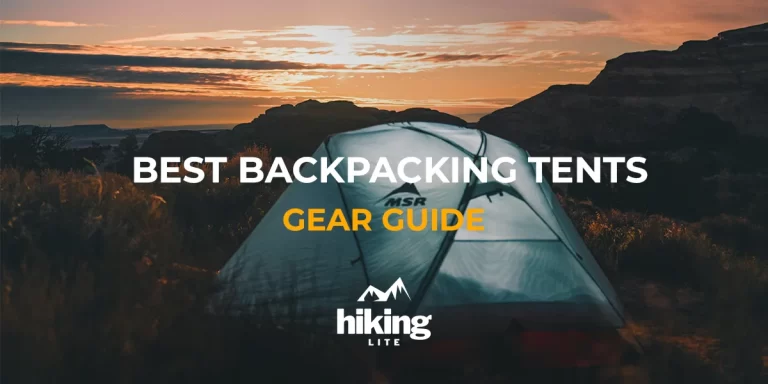
Planning a backpacking trip takes some work. One important decision is selecting the best backpacking tent. A quality shelter can make or break your experience in the wilderness.
If having a lightweight setup is key, ultralight or lightweight backpacking tents may be the best for you. However, with so many options to sort through, it’s easy to end up with one that’s not a good fit.
Fear not, help is here! This guide lists both the five top-rated 1-person and 2-person tents. Don’t let the low weights fool you – these shelters are still very durable.
We’ll examine specs like packed size, weather protection, interior space and ease of setup. Comparing features helps identify which tents are best for your needs and trip plans.
Let’s get started.
Looking for something even lighter? See our post on ultralight trekking pole tents.

Key Specs
Weight: 1lb 10.9 ounces (765g)
Material: 15D nylon ripstop
Price: $$
PROS
✅ Ultralight
✅ Excellent for tall people
CONS
❌ The fly can flap in the wind
❌ Small vestibule
The Big Agnes Fly Creek HV UL 1 is a top choice for lightweight backpacking and is well-suited for three-season adventures.
Setup is simple thanks to Big Agnes’s color-coded clips and poles. The single pole design keeps weight low without compromising stability. The HV (High Volume) body provides generous head and shoulder room that feels surprisingly roomy for a one-person shelter.
Big Agnes uses weather-resistant HyperD Fabric for the fly and mesh inner that has proven very durable over long-term use. Ventilation is excellent with large mesh panels. The vestibule is smaller than some competitors.
The Fly Creek really shines in terms of livability. Features such as pockets, storage loops, and good interior space for a 1-person tent make it comfortable to spend time in during inclement weather. Additionally, the double-door entryway with full mesh ensures excellent ventilation.
My one quibble is that guylines can come loose in strong side winds without additional pole stabilization straps. This results in some fly flapping that disturbs sleep.
Overall, the tried-and-true Fly Creek remains one of the best performing and most livable single-person shelters for the weight.
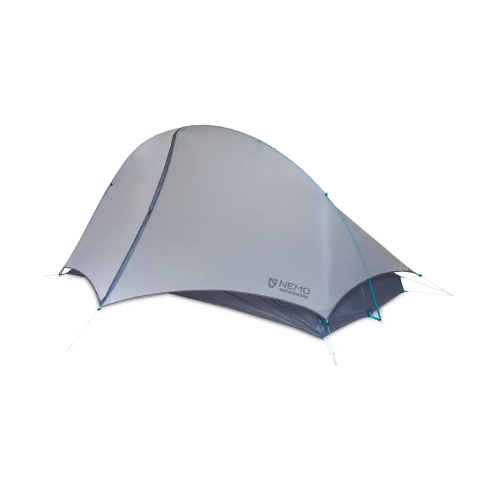
Key Specs
Weight: 1lb 12.6 ounces (812 grams)
Material: poly-nylon composite
Price: $$$
PROS
✅ Great warranty
✅ Next generation materials
CONS
❌ None
The Nemo Hornet Elite OSMO is an excellent highly specialized backpackers seeking an ultralight shelter near the cutting edge of weight savings. At just 1lb 13oz, it is significantly lighter than most backpacking tents on the market.
Nemo’s proprietary OSMO fabric offers best-in-class water resistance for its weight class. During heavy storms, the tent interior stayed perfectly dry, a testament to its weather handling abilities.
Refinements like the innovative Flybar pole strap maximize livable space versus weight. Color-coded clips and lines enable simple, Swift setup and takedown.
Smart features like the Nightlight pocket and overhead vent improve user experience.
Aside from minor pre-existing blemishes in the mesh fabric, no other construction issues or quality concerns were noted during setup or field use of the tent.
For those seeking an optimal balance of protection, comfort and minimalism near the cutting edge of the weight savings possible in a single-person freestanding shelter, few options can match the Hornet Elite OSMO’s performance.
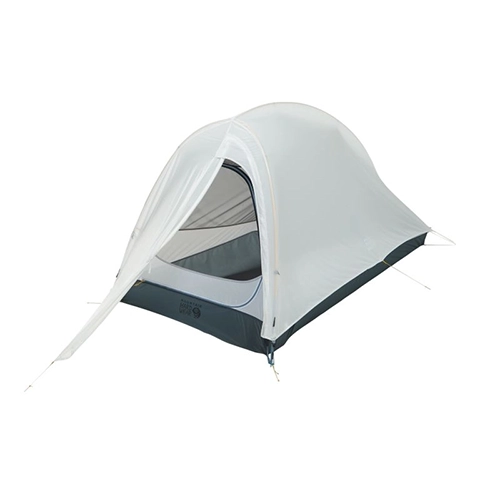
Key Specs
Weight: 1lb 14.7 ounces (872 grams)
Material: 15D nylon ripstop
Price: $$
PROS
✅ High quality
✅ Small pack size
CONS
❌ Some condensation
The Mountain Hardware Nimbus UL 1P tent is an ultralight shelter choice for warm weather trips where pack weight savings and minimalist features take priority.
Constructed from silnylon, the fully waterproof fly sheds weight while maintaining good storm protection. Unique details like the G-hook pole attachments enhance compressibility.
Setup is a breeze with color-coded DAC Featherlite poles clipping directly to the fly. The front entry vestibule and dual zippers promote ventilation.
However, our testing revealed that without additional guylines or top vents, condensation readily accumulates inside during cold, wet conditions common at high elevations. On one cloudy mountain trip, a soaked inner resulted from fly sagging.
Ultralight tents often compromise coverage for ounces saved. While ideal when dry, ventilating moisture seems key to improving the Nimbus’ performance in varied environments.
Overall it shows promise as a 3-season shelter. But without modifications, campers venturing into shoulder seasons or damp locales would be better served by a design incorporating more breathability.
With some tweaks, this could become a go-to minimalist shelter. But as is, condensation issues warrant awareness for intended temperate climate use.

Key Specs
Weight: 2lb 7 ounces (930 grams)
Material: 15D nylon ripstop
Price: $$
PROS
✅ Good headroom
✅ Easy to pitch
CONS
❌ No rainfly loop for the stargaze mode
The Sea to Summit Alto 1P tent is well-suited for lightweight backpackers seeking ample livable space. Its Tension Ridge architecture delivers generous headroom and taller mesh doors than comparable shelters.
Setup is intuitive with color-coded poles clicking easily into place. The variable rainfly allows for adjustable coverage with options like stargazing. Interior space feels airy and never cramped.
Vents at the pole apex expelled moisture efficiently on damp evenings. Materials like the seam-taped fly and YKK zippers ensure durability.
Some additions could improve functionality further. An integrated strap to cinch the rainfly in viewing position would be welcome. Dry vestibule entry is challenging given the semi-freestanding design.
While not truly optimal for dry pitching, the Alto 1P strikes an excellent balance for solo ventures where spacious comfort and minimalistic elegance are priority over full freestanding stability.

Key Specs
Weight: 2lb 15.3 ounces (1343 grams)
Material: 15D nylon ripstop
Price: $
PROS
✅ Great materials
✅ Relatively affordable
CONS
❌ A bit heavy
❌ Not for tall people
The 3F UL Gear Floating Cloud 1 ultralight 1-person freestanding tent offers a lightweight and user-friendly solution for ultralight adventures.
With its straightforward but robust single pole architecture, the tent is built to endure multi-day trips in different terrains and weather conditions.
Packed with features like a large vestibule, storage space, and efficient ventilation to reduce condensation, this tent is fully equipped.
While it might lean a bit towards the heavier side for a truly ultralight option, and taller individuals over 6 feet could find it a tad short, it’s worth noting that the tent’s overall reliability, low price, and practicality remain significant.

Key Specs
Weight: 1lb 13.45oz (835g)
Material: DCF
Price: $$$
PROS
✅ Ultralight
✅ Easy setup
CONS
❌ Minor quality issues
The Zpacks Duplex establishes a new standard for two-person shelter weight at just over 2 pounds with the optional Freestanding Flex Kit.
Setup is remarkably simple – poles slide neatly through sleeves with no fiddly clips or buckles. The symmetrical design allows many flexible pitching configurations.
Internal space feels exceptionally roomy. Two can sit up comfortably or sleep head-to-foot with pack storage at either end. Generous porch areas on all sides enhance livability.
Breathable mesh all around provides unobstructed views. Overlapping doors allow customized ventilation in any conditions. Smart details like mesh pockets improve user experience.
Materials feel sturdy and weatherproof. However, minor production defects and a stiff zipper out of the box were concerning at this price point and warrant monitoring over time.
For minimalist couples pursuing multi-day adventures with unprecedented packweight efficiency, few options currently rival the Duplex.
When durability matches its ingenious design, this shelter will prove unbeatable.
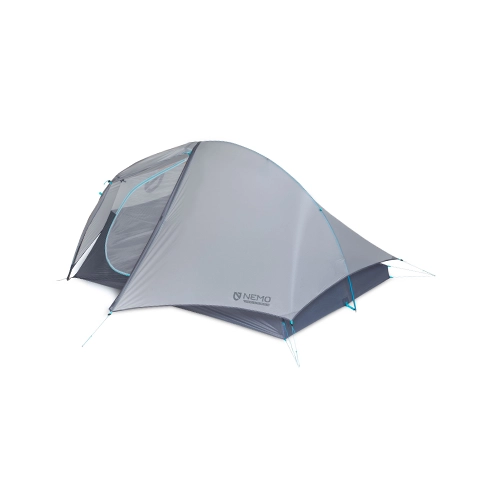
Key Specs
Weight: 2lb 0.9 ounces (935g)
Material: poly-nylon composite
Price: $$$
PROS
✅ Great warranty
✅ Next generation materials
CONS
❌ Not the most spacious
The Nemo Hornet Elite OSMO 2P takes ultralight shelter design to new heights. Advanced OSMO fabric offers unmatched water resistance for the weight class.
Thoughtful updates like the Gatekeeper door tie-backs and Divvy Cube stuff sack enhance user experience on lengthy trips. Patented innovations such as the spacious Flybar pole clip maximize interior volume.
Setup is remarkably simple with color-coded DAC poles clicking smoothly into the single hub. Build quality feels superb throughout.
However, it’s important to note that while there is sufficient space, this shelter is quite snug for two large-sized adults.
Overall, the Hornet Elite OSMO continues to push the boundaries of outdoor minimalism.
However, those seeking a more generous two-person space may want to consider other options.
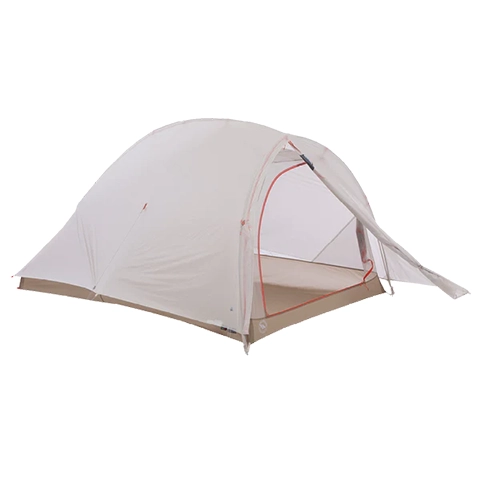
Key Specs
Weight: 1lb 14.9 ounces (878 grams)
Material: 15D nylon ripstop
Price: $$
PROS
✅ Good quality stakes
✅ Excellent for tall people
CONS
❌ The fly can flap in the wind
The Big Agnes Fly Creek HV UL 2 proves a well-rounded 2-person shelter for backcountry adventures. Refinements like sustainable HyperD fabric enhance the award-winning formula.
Its strong structure provided reliable storm protection on a 70-mile AT thru-hike. Intuitive color-coded poles allow swift setup even when fatigued.
Interior storage mesh and thoughtful details promote organization. Spacious headroom and vestibules make time in the tent pleasant despite inclement weather.
However, semi-freestanding dependency on stakes can pose challenges on rocky terrain where stakes fail to secure the structure. Floor durability warrants care on rough surfaces to avoid wear points.
Also, fly noise in strong winds was noticeable until utilizing included guylines for tension.
With care taken in stake-dependent pitching and floor protection, this tent proves a worthwhile choice for lightweight backpackers seeking ample interior space and versatile 3-season use.
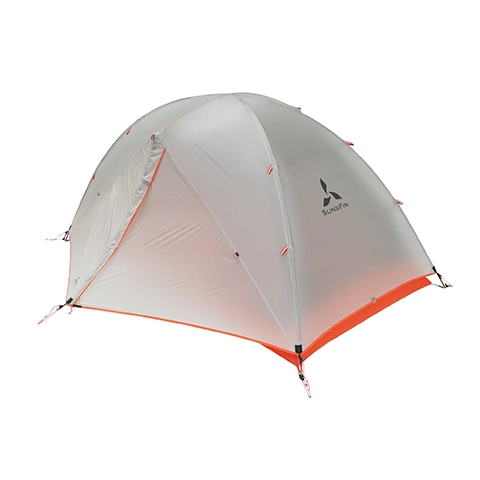
Key Specs
Weight: 2lb 13.8 ounces (1300 grams)
Material: 15D nylon ripstop
Price: $$$
PROS
✅ Good space
✅ High quality
CONS
❌ Not the easiest to set up
The SlingFin Portal 2 establishes a new standard for durable two-person ultralight tents. At just under 3 pounds, its impressive strength-to-weight exceeds expectations.
Clever features like elevated KickStand vents maximize livability without bulk. Generous interior space comfortably fits two individuals and their gear.
Construction materials exude quality, from the long-lasting fly fabric to extra YKK zipper sliders that double service life. Poles feel sturdy yet light.
Setup is simple once familiar, though a two-person pitch proves easiest. The symmetrical design provides versatile vestibule access.
While not as minimal as some alternatives, the Portal 2 strikes an excellent balance for couples pursuing multi-day excursions with ample gear in varied conditions.
Those prioritizing strength over absolute lightness will appreciate its durable design well-suited for challenging environments.
Overall an outstanding freestanding shelter for the weight class.
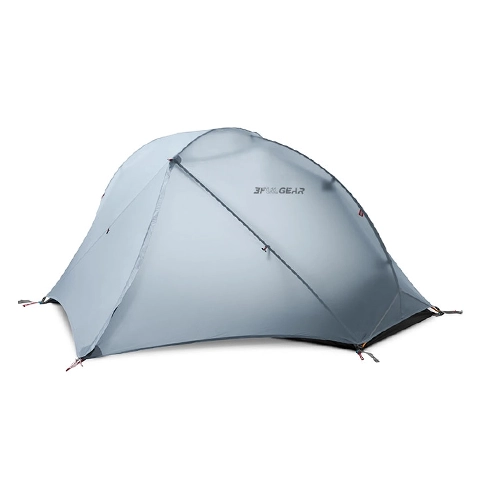
Key Specs
Weight: 3lb 14.7 ounces (1780 grams)
Material: 15D nylon ripstop
Price: $
PROS
✅ Great materials
✅ Relatively affordable
CONS
❌ A bit heavy
❌ Not for tall people
The 3F UL Gear Floating Cloud 2 presents an easily manageable freestanding 2-person shelter for appreciating the outdoors with a companion.
Constructed with sturdy single-pole architecture, this tent stood up reliably to varied weather over several adventure-filled trips. Well-placed vents minimized interior condensation.
Interior space accommodated gear and two comfortably. Thoughtful features like removable floors, vestibules and integrated storage enhance functionality.
While not the absolute lightest, specialized details and build quality complement the very reasonable price point. Dependable performance justified the moderate weight.
Though taller individuals (>6 feet) may find headroom limited, ample head and leg space still support restful nights.
The Floating Cloud 2 proves fully capable of handling anything the backcountry can offer with practicality and minimal fuss.
When choosing the right tent for backapcking, consider three important factors: seasonality, weight, and livability:
Seasonality
Tents are rated for different seasons, from 3-season to 4-season models. 3-season tents work well in spring, summer and fall with warmer nights. Experienced backpackers may have different shelters for winter trips. Consider your typical use.
Weight
Backpack weight matters, so lighter shelters ease carrying gear long distances. However, sturdier materials last. Check minimum trail weight, packaged weight and size when packed. Balance durability with packability.
Livability
Modern designs prioritize spacious interiors and increased headroom for comfort. Features like rainfly color, large doors, vestibule storage, and ample ventilation optimize the camping experience. These enhancements make hunkering down during storms more pleasurable.
Additional Considerations
Other criteria include pole structure, waterproofing, size options for solo/group use, price point, and specialized functions for specialized activities like fastpacking or mountaineering. Read reviews to gauge shelter quality against individual priorities. Test products if possible before a long expedition.
By understanding your needs and these key factors, you can select the best freestanding backpacking tent optimized for enjoyable outdoor adventures.
For more on tent materials, explore our detailed post here.
Looking for something even lighter? See our post on ultralight trekking pole tents here.
When selecting a compact and lightweight backpacking tent, consider the season, weight, livability, pole structure, waterproofing and size to suit your intended hiking, sleeping needs and priorities. Look for a 3-season tent that offers the right balance of durability and packability unless weight is not the priority, then double-walled construction offers better breathability. Prioritize internal space, large doors and vestibules for gear storage. Lighter shelter options may suffice but check reviews to confirm materials withstand varying terrain and weather. This helps determine the best tent to support relaxed and enjoyable outdoor experiences.
Backpacking tents often feature lightweight yet durable materials like polyester or nylon ripstop fabrics for the fly and floor, with mesh netting for improved ventilation. More ultralight options use cutting-edge materials like Dyneema composite fabric, an exceptionally strong and rot-resistant fiber. More heavy-duty shelters may incorporate siliconized polyester or polyurethane coated nylon for their water resistance. Tent poles are typically one of three options – aluminum for strength and affordability, carbon fiber for maximum sturdiness to weight ratio, fiberglass which splits the difference, or lightweight Dyneema poles. Quality zippers from companies like YKK titanium or duraflex plastic add longevity. Seams are typically seam-sealed using silicones or PU to shed water and mud over years of use in varying backcountry conditions.
When evaluating options from top backpacking tent brands, critically assess key factors such as weight, season rating, pole structure, floorplan, included features, weather resistance, quality of materials used, ease of setup, packed size, warranty, reviews from buyers, and price to determine the best fit for your specific needs and intended activities. Read in-depth reviews that provide details on real-world durability and performance, then compare top contenders side-by-side before selecting the brand and model best suited to support comfortable and enjoyable overnight excursions.